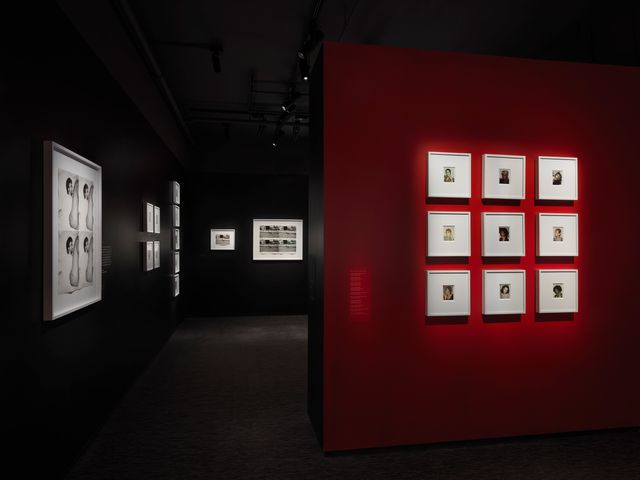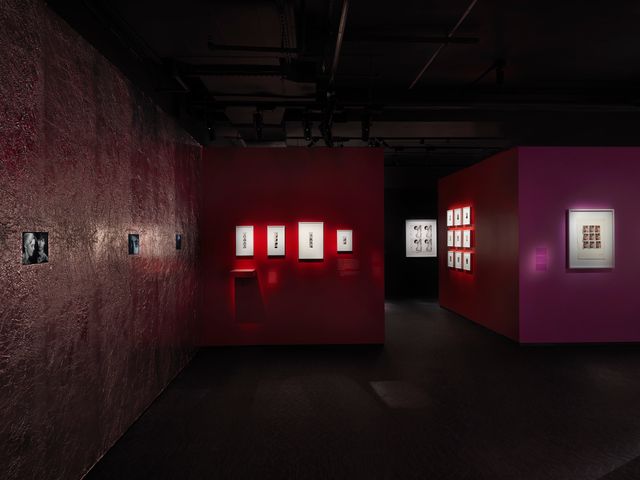
Andy Warhol exhibit has been extended at Fotografiska through February 20 (photo by Dario Lasagni)
ANDY WARHOL: PHOTO FACTORY / ANDERS PETERSEN: COLOR LEHMITZ
Fotografiska
281 Park Ave. South at Twenty-Second St.
Open daily, $16-$26, 9:00 am – 9:00 pm
www.fotografiska.com/nyc
When I told a good friend of mine who teaches visual art that we were going to make our first visit to Fotografiska, she immediately asked, “Why?” The institution refers to itself as “a museum experience for the modern world,” with locations in Estonia, Sweden, Shanghai, and, soon, Berlin and Miami. It opened in the landmarked Church Missions House on Park Ave. South in December 2019, only a few months before the pandemic lockdown. It is not for everyone; seeing a show can feel like attending a gallery opening, with groups of people drinking cocktails, chatting away, and taking their time to get just the right picture of themselves in front of the photographs. Fotografiska’s motto is: “Have fun. Stay late. Get deep. Spill your drink.”
When we went, we saw a few disappointing, uninspiring exhibits; one relied on a slide show and reproductions of the work instead of original pieces, and two others were accompanied by poorly translated wall text. But across the six floors were two eye-opening presentations that make a trip to Fotografiska a must, even if you are not going to down martinis and snap away into the night.
Continuing through February 20, “Andy Warhol: Photo Factory” consists of more than 120 rarely or never-before seen works by Andy Warhol, from shots of familiar celebrities to photobooth strips to eight remarkable stitched photographs and studies from his 1974 Polaroid series “Ladies and Gentlemen,” of trans people and drag queens; he later turned some of these images into silkscreens. A pair of men in tuxedos serve food to a smiling Jean-Michel Basquiat. Keith Haring stands with his arm around Dolly Parton by a pond. Grace Jones is draped in white fur, black gloves, and a red scarf.

Andy Warhol exhibit at Fotografiska includes rarely seen images (photo by Dario Lasagni)
In one area, pictures are arranged on wallpaper depicting high-heeled shoes; several Screen Tests peek out from a wall covered in silver foil. Nine small nudes are arranged in three rows, primarily focusing on buttocks. Quotes from Warhol’s published diaries accompany some works.
The most impressive room contains Warhol’s little-seen stitched photos, in which he took one picture, made duplicates, then stitched them together with thread to create something wholly new, three-dimensional repeated images, loosely held together, of nudes, a beach landscape, and Steven Spielberg. The hand of the artist is key to Warhol’s success here; he went everywhere with his camera, becoming his own Instagram, taking photos that, essentially, anyone could have, in photo booths, with a Polaroid camera, threading some together himself. But, of course, nobody’s Instagram page will ever match his.
Even the introductory text is better, written by culture writer and curator Vince Aletti, who notes, “Andy Warhol’s art has been so thoroughly absorbed into the culture that it’s difficult to imagine the shock, consternation, and thrill it once provoked. He was a joke; he was a genius. His Pop was the purest, the shrewdest, the wittiest — both the most straightforward and the most confounding.” It is this dichotomy that keeps Warhol so popular, both among serious art lovers and people who just want to have some fun, stay late, and spill their drink.

Anders Petersen’s Café Lehmitz series features large-scale contact sheets (photo © Anders Petersen)
The other must-see exhibit at Fotografiska is “Anders Petersen: Color Lehmitz,” through March 6. The show zeroes in on the Stockholm-born photographer’s pictures taken in Café Lehmitz in the late 1960s, shots of men and women having fun, staying late, and drowning themselves in drink. He invites the viewer into the seedy joint, where members of a motley crew play around, get into fights, smoke, and fall in love in a port neighborhood filled with sailors and brothels.
“The people at Lehmitz had a presence and a sincerity that I myself lacked,” Petersen, who goes everywhere with a camera on his belt, says about the series. “You were allowed to be desperate, tender, sit by yourself, or become part of the community. In the vulnerability, there was a lot of warmth and tolerance.” In a short documentary, Petersen explains that when he takes photos, he thinks of them as a book, not just individual images. In the wall text, curator Angie Åström writes, “The photos from Cafe Lehmitz become a kind of family album.”
In an accompanying slide show, Lehmitz, who is in his late seventies — he was twenty-three when he took these photos — talks about many of the photos, recounting each individual, sharing barroom stories about them. If you get the feeling that you’ve walked into a Tom Waits album, you’ve grasped the aesthetic: Petersen’s original photo of a shirtless man with tattoos snuggling into the neck of a laughing woman (“Lilly och Rose”) became the cover of the gravelly voiced singer and actor’s 1985 album, Rain Dogs,.
In other photos, four men argue over beers. A man stands alone against a pole, looking right into the camera, blowing out smoke from his cigarette. A woman seems surprised when a man puts his hand up her shirt, the jukebox and a door with broken glass in the background. A couple Petersen refers to as Bonnie and Clyde smoke while leaning on a pinball machine. A woman puts her hand to the face of an elderly man who blankly stares out at nothing, as if she is checking for signs of life.

Anders Petersen documents the denizens of a Hamburg café in powerful series (photo © Anders Petersen)
The photos also come to life in a series of contact sheets Petersen processed in the late 1960s for the publication of his Café Lehmitz book. Seen in large-scale, the decaying sheets contain yellow and red dots, cross-outs in black, and yellow and green tints, featuring not only the images that he would use in the book and can be seen on their own in the exhibition but additional takes that were not used but form their own narrative on these sheets, as if stills from a film that was never made.
“It’s a place that I absolutely don’t want to romanticize, since the circumstances were anything but that,” Petersen explains. “But there was still that universal togetherness and presence that is often missing from fancy parlors or properly lit break rooms. That thing that many of us are longing for, but that our culture seldom gives us the tools for, to let us really connect with each other.”
Petersen’s photographs give voice to the marginalized, the disenfranchised, lonely people seeking solace in a life that might not have quite gone the way they expected. But Petersen makes no judgment about them, instead merely depicting them as they are, celebrating each and every one, and we are all the better for it.